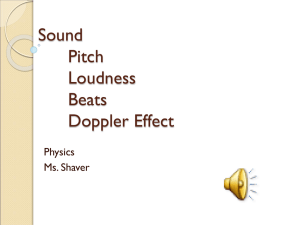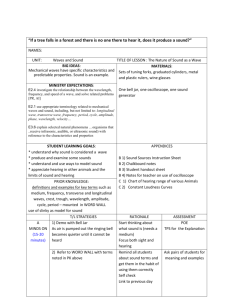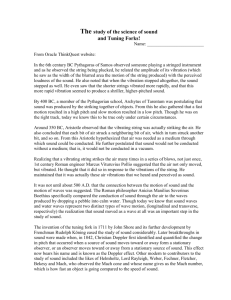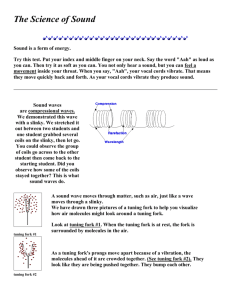Lesson 2 Wave Properties and Sound
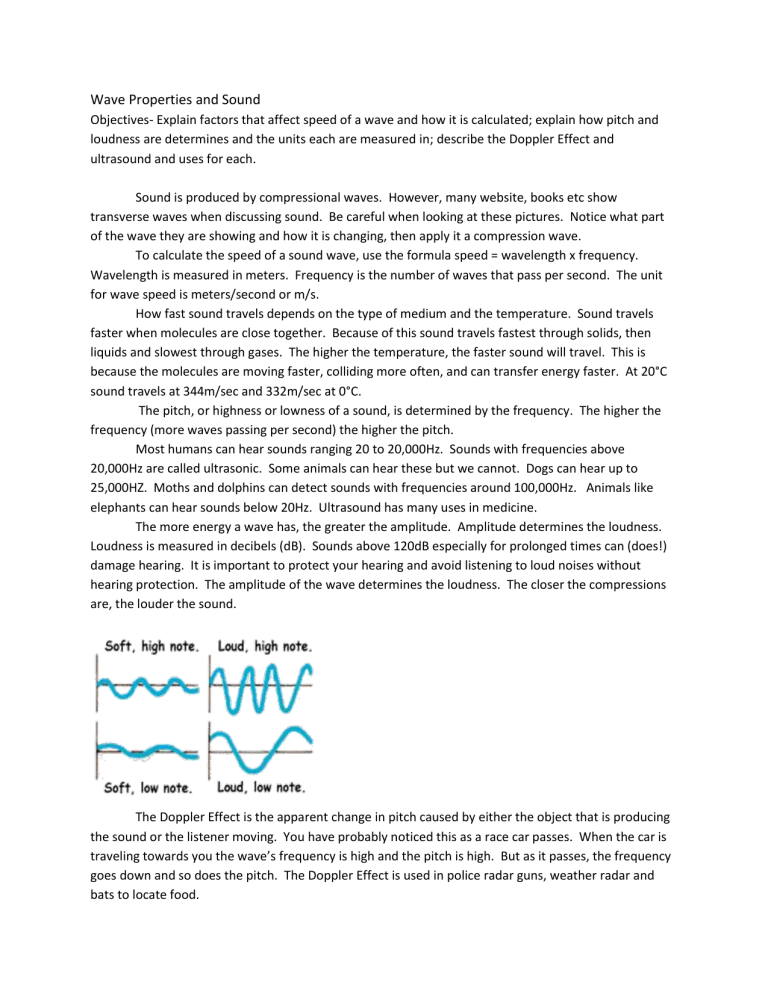
Wave Properties and Sound
Objectives- Explain factors that affect speed of a wave and how it is calculated; explain how pitch and loudness are determines and the units each are measured in; describe the Doppler Effect and ultrasound and uses for each.
Sound is produced by compressional waves. However, many website, books etc show transverse waves when discussing sound. Be careful when looking at these pictures. Notice what part of the wave they are showing and how it is changing, then apply it a compression wave.
To calculate the speed of a sound wave, use the formula speed = wavelength x frequency.
Wavelength is measured in meters. Frequency is the number of waves that pass per second. The unit for wave speed is meters/second or m/s.
How fast sound travels depends on the type of medium and the temperature. Sound travels faster when molecules are close together. Because of this sound travels fastest through solids, then liquids and slowest through gases. The higher the temperature, the faster sound will travel. This is because the molecules are moving faster, colliding more often, and can transfer energy faster. At 20°C sound travels at 344m/sec and 332m/sec at 0°C.
The pitch, or highness or lowness of a sound, is determined by the frequency. The higher the frequency (more waves passing per second) the higher the pitch.
Most humans can hear sounds ranging 20 to 20,000Hz. Sounds with frequencies above
20,000Hz are called ultrasonic. Some animals can hear these but we cannot. Dogs can hear up to
25,000HZ. Moths and dolphins can detect sounds with frequencies around 100,000Hz. Animals like elephants can hear sounds below 20Hz. Ultrasound has many uses in medicine.
The more energy a wave has, the greater the amplitude. Amplitude determines the loudness.
Loudness is measured in decibels (dB). Sounds above 120dB especially for prolonged times can (does!) damage hearing. It is important to protect your hearing and avoid listening to loud noises without hearing protection. The amplitude of the wave determines the loudness. The closer the compressions are, the louder the sound.
The Doppler Effect is the apparent change in pitch caused by either the object that is producing the sound or the listener moving. You have probably noticed this as a race car passes. When the car is traveling towards you the wave’s frequency is high and the pitch is high. But as it passes, the frequency goes down and so does the pitch. The Doppler Effect is used in police radar guns, weather radar and bats to locate food.
Questions
1. What type of wave produces sound?
2. What is the speed of sound through air at 20°C? Which is faster- sound or light?
3. What will sound travel fastest through, water or a brick wall? Why?
4. What happens to the speed of a sound wave as temperature is increased?
5. Define pitch
6. What is the unit used to measure a sounds pitch with?
7. What factor of a sound wave determines the pitch?
Activity-
Materials- 2 tuning forks (128Hz and 256Hz) with toothpick taped to it, foil
Procedure-
1. Hit each tuning fork into your hand then quickly and lightly, drag the toothpick across the foil.
Compare the waves made by each. Which one makes more waves? Compare the pitch each makes.
Which one has a higher pitch?
8. What is the range of sound frequencies most people can hear?
9. What are sounds called that are above 20,000Hz? What are they used for?
10. What unit is used to measure a sound’s loudness with?
11. What property of a sound wave determines its loudness? What feature of a wave shows how much energy there is?
Activity
Materials- ring stand with ball hanging from it, tuning fork with wood base, rubber mallet
Procedure-
1. Lightly tap the tuning fork with the mallet. Then slide the tuning fork over so it touches the ball. How loud is the tuning fork? How far does the ball move?
2. Repeat, but this time hit the tuning fork with more force. How loud is the tuning fork this time? How far does the ball move?
12. What does this activity show about the amount of energy and loudness?
13. Describe the Doppler Effect.


